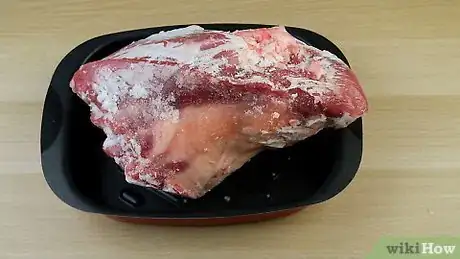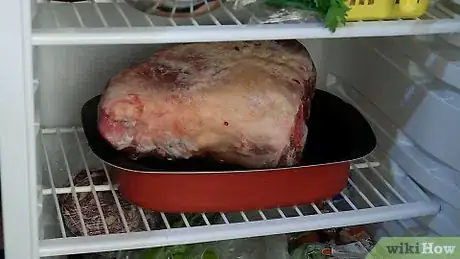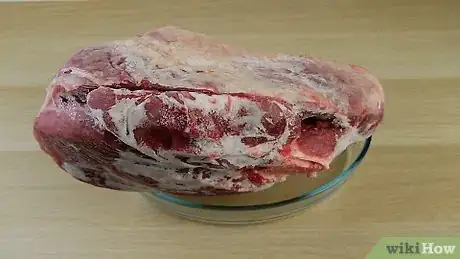This article was co-authored by Marrow Private Chefs and by wikiHow staff writer, Eric McClure. Marrow Private Chefs are based in Santa Rosa Beach, Florida. It is a chefs’ collaborative comprised of an ever-growing number of chefs and culinary professionals. Though regionally influenced primarily by coastal, traditional southern, cajun, and creole styles and flavors, the chefs at Marrow have a solid background in all types of cuisine with over 75 years of combined cooking experience.
This article has been viewed 67,933 times.
Whether you’ve got an uncooked bone-in ham or want to serve those slices you’ve been storing in the freezer, there are several ways that you can defrost ham. The best way to safely defrost a ham is to store it in your refrigerator, but this can take up to a week for larger hams. Another option is to place your ham in a large plastic bag and soak it in cold water for several hours. If you’re really in a pinch, you can microwave smaller hams, although this method will change the texture and flavor of the meat and you may accidentally cook the outer layers of the meat.
Steps
Thawing Ham in the Refrigerator
-
1Place your ham in a deep-rimmed pan of bowl. Search your cabinets for a large-rimmed bowl or baking pan that is bigger than your ham to collect water as the ham thaws. Take your ham out of the freezer and leave it wrapped in the aluminum foil or packaging. If you’re defrosting slices of ham, place them in an airtight bag. Set your ham in the pan or bowl.[1]
- This method takes the most time, but it’s the best way to thaw ham safely and evenly.
Tip: Keeping your ham wrapped will keep your fridge from reeking of salted meat while keeping other food smells out of your ham.
-
2Put your ham in the fridge and leave it for 4-6 hours per pound. Open the fridge and place your pan or baking sheet inside. The time it takes for your ham to thaw entirely depends upon the weight of your ham. For smaller hams, leave them in your fridge for 4 hours for every 1 lb (0.45 kg) of ham. Larger hams require 6 hours per 1 lb (0.45 kg) of meat.[2]
- For example, if you have a large 18 lb (8.2 kg) ham, multiply 18 by 6 to get 108 hours. This means that you’ll need to leave your ham in the refrigerator for 4.5 days to fully thaw it.
- If you have slices of ham that you’re thawing, you will likely be able to thaw them in 12-24 hours.
- Place the ham in the refrigerator for 24-48 hours, depending on its size, to allow it to defrost slowly.
- A small ham (5-7 pounds) may take 24 hours to defrost, while a larger ham (10-15 pounds) may take up to 48 hours.
- You can leave an uncooked ham in the fridge for 1 day after it’s thawed. You can leave a cooked ham in the fridge for up to 3 days after it’s thawed.
Advertisement -
3Remove your ham from the fridge and cook it immediately. Take your ham out of the fridge and cut through it with a carving knife. If the knife moves effortlessly through the ham, it’s fully thawed. If you thawed an uncooked ham, plan on cooking it immediately after you’ve removed it. If you’ve thawed a cooked ham, take it out of the refrigerator and remove the packaging before serving it. You can heat it if you’d like, but cold ham is a delicious dish as well![3]
- If the ham isn’t fully thawed, pop it back in the fridge and leave it for another 2-12 hours based on how frozen it is.
- Keep the bone after you’ve finished eating a bone-in ham. It can be used to make a delicious broth!
- If your plans change, you can refreeze your ham if it hasn’t spent more than 3 days in the fridge.
Using Cold Water to Defrost Ham
-
1Place your ham in a sealable plastic bag and seal it. Take your ham out of the freezer and remove it from its original packaging. Take a large plastic bag that your ham will fit into and open it at the top. Carefully transfer your ham into the bag and use both hands to press the air out before closing it.[4]
- This method is much faster than thawing it in the fridge, but it requires a little more effort on your part. You also won’t be able to refreeze the ham afterwards.
- If your ham is really big, it can be kind of a pain to find a bag big enough for it. Look for extra-large food storage bags in your grocery store to pick some up.
- If you’re thawing sliced ham, you can thaw it in its original packaging so long as it’s sealed and airtight.
- You can’t thaw your ham under warm water. If you do, the outer layers of your ham may get warmer than 40 °F (4 °C), which is the minimum threshold for dangerous bacteria to grow in your meat.
-
2Submerge your ham in cold tap water for 30 minutes per pound. Get a big pot out and place your ham inside to make sure that your ham fits. Then, turn your sink on and set it to the coldest temperature. Wait 45 seconds to give the water time to cool and place your pot into the sink. The thaw time is dependent upon the size of your ham. Thaw it for 30 minutes for every 1 pound (0.45 kg) of ham.[5]
- For example, if your ham is 12 lb (5.4 kg), multiply 12 by 30 to get 360 minutes. This means that you’ll need to thaw a 12 lb (5.4 kg) ham for 6 hours in cold water.
- Sliced ham can be thawed this way in 1-2 hours.
Warning: The exterior of your ham cannot exceed 40 °F (4 °C), so you may need to chill water in your fridge or add ice to the pot to get the water temperature down if your tap isn’t that cold.
-
3Change the water out once every 30 minutes to keep it cold. The water in your pot will start to warm as it’s exposed to the air around it. To prevent the water from warming up, replace the water once every 30 minutes. Turn your tap on to the coldest setting and tilt the pot over to empty out the old water. Refill your pot and turn your tap off.[6]
-
4Cook or serve the ham as soon it has been thawed. When you’ve thawed your ham for the required time, take it out of the pot and try cutting through it with a carving knife. If the knife cuts easily through the ham, it’s ready to be cooked or served. If it isn’t ready yet, put it back in the bag and thaw it for another 1-2 hours.[7]
- You cannot refreeze a ham that has been thawed in cold water.
Microwaving Ham to Thaw it
-
1Place your frozen ham in a microwave-safe container. Go to your cabinet and find a microwave-safe container that is big enough to hold your ham. Glass and unpainted ceramic are safe, but you can always check the bottom of a bowl, pan, or plate for “microwave-safe” or 3 wavy lines (the international symbol for microwavable materials). Remove the wrapping on your ham and place it on the plate or pan.[8]
- This method is the fastest, but it’s widely accepted as the worst way to thaw ham. You may accidentally cook part of the ham, and it will change the texture of the meat to make it less pleasant. Still, if you’re in a pinch, you can thaw your ham in the microwave.
- The ham has to fit in the microwave. This means that most medium and large hams can’t be thawed this way.
Warning: This is a bad way to thaw cooked or sliced ham, since it may heat the seasoning or glaze at a different rate than the rest of the meat.
-
2Microwave the ham for 15-45 minutes on the defrost setting. Place your ham in the microwave and set the microwave to defrost. If your microwave doesn’t have a defrost setting, set the microwave to its lowest power setting. Smaller hams can be thawed in roughly 15 minutes, but thicker or bigger hams may take up to 45 minutes to thaw.[9]
- Check the ham once every 5-10 minutes by pressing it to see if it’s softening up. If it’s soft, try cutting the ham. If you can get a knife easily through the ham, it’s thawed.
-
3Cook your ham immediately after you’ve thawed it. This step is especially important if you’re microwaving ham, since some of the meat may have cooked in the microwave. As soon as your ham is thawed, take it out and cook it. You cannot re-freeze ham if you thawed it in the microwave.[10]
Warnings
- Do not thaw your ham on the countertop. As the outer-layers of your ham warm up, bacteria can grow in the meat. This may lead to foodborne illnesses.⧼thumbs_response⧽
Expert Interview

Thanks for reading our article! If you'd like to learn more about cooking, check out our in-depth interview with Marrow Private Chefs.
References
- ↑ https://whatscookingamerica.net/Pork/Ham101.htm
- ↑ https://ask.usda.gov/s/article/Ham-thawing-time
- ↑ https://ask.usda.gov/s/article/Ham-thawing-time
- ↑ https://www.stilltasty.com/articles/view/87
- ↑ https://www.stilltasty.com/articles/view/87
- ↑ https://ask.usda.gov/s/article/Ham-thawing-time
- ↑ https://ask.usda.gov/s/article/Ham-thawing-time
- ↑ https://www.stilltasty.com/articles/view/87
- ↑ https://www.fsis.usda.gov/wps/portal/fsis/topics/food-safety-education/get-answers/food-safety-fact-sheets/safe-food-handling/the-big-thaw-safe-defrosting-methods-for-consumers/ct_index























































